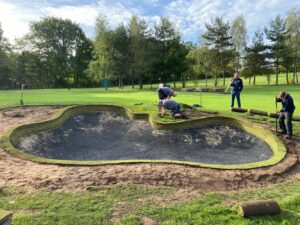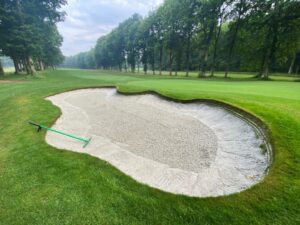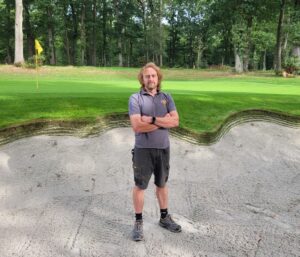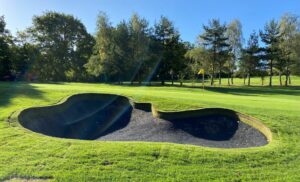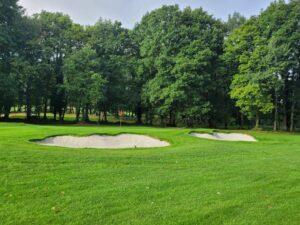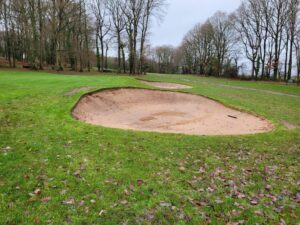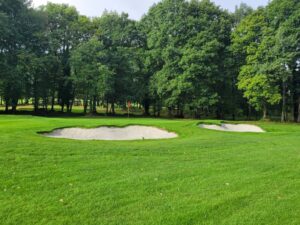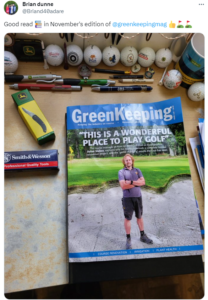“This is a wonderful place to play a round of golf”
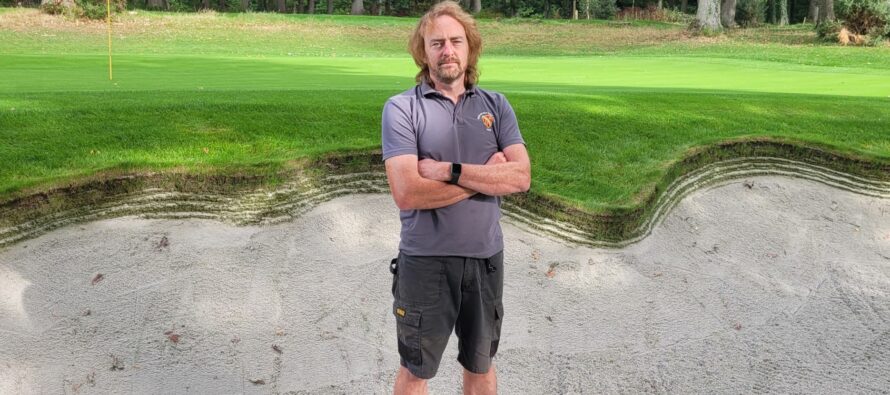
Related Articles
The course manager at Ross on Wye Golf Club in Herefordshire, Dylan Stokes, talks about maintaining the course and how and why his team undertook a complete bunker renovation project, and the ‘game changing’ results they have since seen.
What is your background and how did you come to be course manager at Ross on Wye GC?
I started my working life as a gamekeeper for my local shoot. I spent seven very happy years doing the job I had always dreamed about as a boy. Being outside, for me, is an absolute necessity. For some reason, and I’m not sure why I fancied a change, I applied to a job advert at a local golf course but also sent my covering letter to all the golf courses around me. A couple of weeks later I heard back from one, Dymock Grange GC, a small nine-hole course only seven miles away. I spent a year there working one-to-one with the head greenkeeper.
Being a small course, and only the two of us, it was a great way to get to do all the jobs without there being a hierarchy. A year later and out of the blue, Jonathan Wood, course manager at Ross on Wye GC, rang me. They were just starting their centenary year and wanted to expand their team. I moved to Ross in 2003 and spent 15 years as a greenkeeper, then becoming a senior greenkeeper. I got to a stage where I felt I needed to step up the ladder and another local course was looking for a head greenkeeper. I applied for the job and was successful. Working on a modest budget and with a small team, we really made some great progress. Eighteen months later, the course manager job came up back at Ross on Wye GC and here I am!
Can you tell us a little about the course and the general maintenance practices and challenges you face?
Our course is a woodland course nestled among the oaks that was part of Dymock woods. It’s on very heavy clay which comes with the usual problems that’s associated with clay. It takes until May for the ground to start to warm up. Once it has warmed up, it bakes solid and the less we talk about drainage the better. I have found, however, some of the old-fashioned practices work really well on the clay. Especially mole draining into the existing drainage system. We also Verti-drain and Shockwave the whole course twice a year. These are all vital practices to help break through the solid clay and reconnect the surface with the drainage system. Leaves are also a challenge for us, taking most of our time up from November to early January. But when everything comes together and the sun is shining it really is a wonderful place to play a round of golf.
What were the drivers that led the club to undertake a complete bunker renovation?
Initially, the club carried out a course survey and it was very apparent that the bunkers were the main area of concern for the majority of members. We have worked hard on greens, tees and fairways in recent years but the bunkers were a source of frustration among the members and also myself and my team. They were washing out in places, holding water, contaminated and not particularly enjoyable from a playing perspective. They also just looked a bit bland and added very little to the course visually. The club was very clear that to bring the golf course up to the standard we all desired, the bunkers would need significant work and a major renovation was required.
How did you go about choosing a partner company to work with you on the renovation?
We spoke with several companies and received quotes from a few. The reality was that we simply didn’t have the budget to commission a traditional contractor to renovate our bunkers, and that we would have to look at alternative ways of bringing our ambitions to life. We spoke at length to Durabunker during the planning phase and were offered a flexible model that essentially meant we could bring the project in within budget. We were also very drawn to their approach which was collaborative and meant myself and my team could get involved and learn some valuable skills to carry forward. We were taken by their vision for the project and their objective advice on things such as liners, design styles and models of execution that they offered.
What execution model did you use to implement the renovation, and why?
We landed on an execution model that essentially fitted with our budget, but also ticked boxes in relation to development of the greenkeeping team. We decided on a phased approach to tackle the project in three key stages, but initially we worked with Durabunker to build two trial bunkers, before agreeing on a full bunker renovation. The trial gave us an opportunity to understand a little more of what was required, assess the products Durabunker had recommended and also get a feel for them as a company. We were impressed on all fronts and so we commissioned a wider project fairly shortly after the trial bunkers were built. The first major phase of works involved Durabunker leading the build of several bunkers, which included preparation, shaping and construction work, installing their rubber crumb liner and synthetic edge and then leading us through the finishing work. We were pretty much novices at bunker construction at that point, but Durabunker were excellent in terms of training our team and ensuring we all understood the process from start to finish. My team picked up the necessary skills and knowhow pretty quickly and were chomping at the bit to be let loose, so to speak. I was tasked with carrying out the machine and shaping work, as I had a good bit of experience on the machine, though not necessarily in terms of bunker construction. Rhydian Lewis, from Durabunker, spent time with me on site to work through this element of the project which he emphasised was key to the overall success, leading me through the shaping work on those first few bunkers, and guiding me along the way.
What has been the role of your team and Durabunker?
The team has been heavily involved in the work, initially learning from Durabunker and then as the project developed, being given much more autonomy in terms of the preparation work and installation of product. They’ve done everything from digging out, drainage, ensuring correct gradients for bunker slopes, installing Durabunker’s synthetic edging and all the tie-in and finishing works. Durabunker for their part obviously led us through the initial stages of the project and trained the team in every facet of the construction work and then, as my team developed the required skills and experience, Durabunker gradually pulled back and spent less time on site. Their role eventually became that of setting out the shapes of bunkers, approving the preparation work and final bunker shapes and keeping an eye on the build as it progressed. They installed the rubber crumb liner for the entirety of the project, with my team installing the synthetic edge for the most part but the majority of the work, particularly in phases two and three, which was carried out by my team, with Durabunker playing the role of consultants via scheduled days on site at key stages of the work.
What have you learnt through the project?
Attention to detail has been one thing of note throughout the work. Durabunker impressed on us key construction principles, such as not building bunker slopes that were more than the angle of repose of the sand we were using. So, we kept the angles of sand faces between around 25 and 30 degrees. This has helped with sand retention on slopes and wash out, whilst at the same time making the bunkers more visible and impactful on the golfer’s eye. We learnt that single large bunkers can often be split into two smaller bunkers, with cumulatively less sand area whilst looking so much more appealing to the eye and presenting the golfer with better angles, lines and depth perception. A classic example of this was on our short par three 12th hole, which is a signature hole. There was a very big sprawling bunker to the right side of the green, a nightmare to maintain and had grown to look unseemly over the years. Durabunker suggested it be split into two bunkers, offset at an angle with the back one raised so that both were clearly seen from the tee. They look fantastic, really framing the green complex well, whilst also offering a new perspective of how long the green is (it’s pretty long) and giving us coverage of a back right pin. We also learnt about the importance of shaping the landscape around the outside of bunkers, to divert water or form barriers to it. An example of this was our 13th hole, where the front right bunker flooded regularly due to the fairway all sloping downwards towards it, so in effect it acted like a catch basin. As well as installing drainage into the bunker, we installed a secondary catch drain outside the bunker and shaped the area behind the bunker to divert water into the drainage and away from the back of the bunker. The difference has been pretty remarkable. These were things that we would almost certainly not have thought about, but have learnt from Durabunker’s involvement in the project.
As far as myself and my team is concerned, I feel a lot more confident on the excavator, my shaping skills have definitely improved, that’s for sure! The team have worked through the entire process of bunker construction including how to install a revetted edge and the importance of good finishing work. There have been so many benefits gained through the project.
What is the member feedback?
Members are delighted with their new bunkers. They love the new look of them and actually really enjoy playing out of them, which is a first! Durabunker advised on sand selection, we eventually decided on China Clay, it looks fantastic and is also very stable. It’s rare that a project is met with such universal praise so it’s very satisfying after all the hard work, to know the members very much appreciate it.
What maintenance savings have you seen?
It’s been a Godsend really. The reality is we didn’t have a lot of breathing space in the regular course maintenance practices for bunker work. We’re a heavily tree lined golf course, so leaf clearance is a real challenge for us through autumn and there are always so many general course maintenance challenges. Our priority, as with all greenkeeping teams, are the greens. We’ve worked very hard over the past number of years to ensure we present our members with some of the best quality putting surfaces in the area. Maintaining bunkers has been a challenge for us and as a result they have not been kept in the condition we would have liked, having to wait sometimes days for them to dry out after heavy rains, knowing sand is contaminated and not having the means to do much about it. Seeing the erosion of edges and the generic shapes forming over the years due to our own edging work, has been another frustration. However, what we now have are bunkers that drain exceptionally well, don’t hold water, even after heavy downpours, clean sand, stable edges and bunkers that don’t wash out. It’s a greenkeeper’s dream! Much of this is influenced by the products Durabunker have supplied. The rubber crumb liner is working exceptionally well for us and knowing the shaping work we’ve spent so long getting right is now safeguarded for decades thanks to Durabunker’s synthetic bunker edge is an absolute game changer for us.
We have looked closely at irrigation patterns and adjusted where necessary to get 360 coverage and ensure the natural turf installed on top of the synthetic edge, as a finishing turf, is getting adequate coverage. This is important during the establishment phase as the synthetic edging doesn’t offer the same nutrient and growing bed for the natural turf that sits on top of it. We’ve also followed an aftercare programme for the natural turf involving the application of Trismart wetting agent, mixed with Seamax Seaweed to improve moisture retention and increase root mass. We’ve also applied a growth regulator (PGR). There are several benefits to this. It keeps edges looking healthy and green, and halts plant growth, meaning it will help in thickening the sward. It also reduces the reliance and amount of water needed as it stops the cells of the plants extending so quickly. We applied a small amount of liquid fertiliser at the same time to stop stress and encourage plant health. We repeat this process every four weeks throughout the growing season. This has led to healthy turf edges that have established really strongly and been resistant for example to the really hot dry spell we had over four or five weeks of the early summer. As Durabunker emphasised, aftercare is limited but very important, particularly through the establishment phase and ensuring adequate coverage from existing irrigation has also certainly helped in that respect.
What advice would you give to other golf clubs that are considering a bunker renovation?
My top tip would be to consult the experts. As greenkeepers we’re pretty competent at most things related to the upkeep and maintenance of a golf course, but there are people out there with more experience in certain aspects of golf course construction, one area of which being bunker renovations. It has been very reassuring to have Durabunker initially lead the project and then guide us along the way. To have them on hand to lean on and support the build at every juncture has been very reassuring, we certainly would not have achieved the results we have without their involvement.
If you can involve your team and develop their skills along the way, not only will it benefit everyone in their career progression, it will mean that everyone is invested in the project and team morale and job satisfaction will also improve. I’m very proud of what my team has achieved through this project, as are they. They’ve really bought into it, enjoyed the process from start to finish and we all feel a sense of satisfaction at the transformation the project has brought to the golf course.

